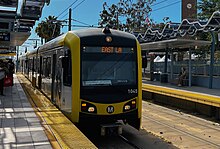Los Angeles Metro Rail
The Los Angeles Metro Rail is an urban rail transit system serving Los Angeles County, California, United States, consisting of six lines: four light rail lines (the A, C, E and K lines) and two rapid transit lines (the B and D lines), serving a total of 101 stations. The system connects with the Metro Busway bus rapid transit system (the G and J lines), the Metrolink commuter rail system, as well as several Amtrak lines. Metro Rail is owned and operated by the Los Angeles County Metropolitan Transportation Authority (Metro).
Los Angeles Metro Rail has been extended significantly since it started service in 1990, and several further extensions are either in the works or being considered. In 2023, the system had a ridership of 61,981,300 or about 205,800 per weekday as of the second quarter of 2024.
Los Angeles had two previous rail transit systems, the Pacific Electric Red Car and Los Angeles Railway Yellow Car lines, which operated between the late 19th century and the 1960s. The Metro Rail system uses many of their former rights-of-way, and thus can be considered their indirect successor.
Current system
[edit]Lines
[edit]In Los Angeles Metro terminology, common with most other metro systems, a line is a named service, defined by a route and set of stations served by trains on that route. (The word does not refer to a physical rail corridor, as it does in New York City Subway nomenclature.)
Metro also uses the same line letter naming system for its Metro Busway services (which are bus rapid transit routes operating in transitways).
Six Metro Rail lines operate in Los Angeles County:[3]
| Line name | Stations | Termini | Type | |
|---|---|---|---|---|
| Western/Northern | Eastern/Southern | |||
| 44 | APU/Citrus College | Downtown Long Beach | Light rail | |
| 14 | North Hollywood | Union Station | Rapid transit | |
| 14 | Redondo Beach | Norwalk | Light rail | |
| 8 | Wilshire/Western | Union Station | Rapid transit | |
| 29 | Downtown Santa Monica | Atlantic | Light rail | |
| 7 | Expo/Crenshaw | Westchester/Veterans | Light rail | |
The B and D lines follow a fully underground route, and the C Line follows a fully grade-separated route. The A, E, and K lines run in a mix of environments, including at-grade in an exclusive corridor, street running, elevated, and underground.[3]
The two rapid transit (subway) lines (B and D) share tracks between Union Station and Wilshire/Vermont, while two of the light rail lines (A and E) share tracks between Pico and Little Tokyo/Arts District.
Stations
[edit]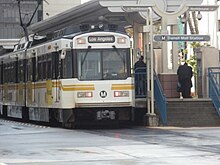
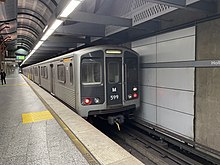
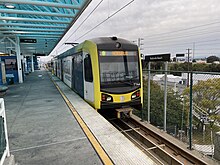
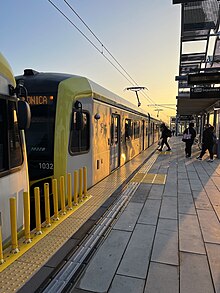

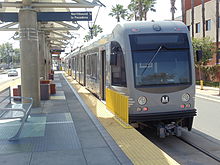
The Los Angeles Metro Rail system consists of 101 stations. The light rail stations are either at ground level or elevated, with some trenched or fully underground. All rapid transit stations are fully underground.[3]
Stations include at least two ticket vending machines, wayfinding maps, electronic message displays, and bench seating. Call boxes are available at stations to allow employees at the Metro Rail Operations Control Center to assist passengers with concerns. Unique artwork is integrated into every station, showcasing local culture and improving the aesthetic of the system.[4]
Street-level stations are typically simpler with platforms designed with shade canopies, separated from nearby roads and sidewalks, where passengers can purchase fares and board a train. Free or paid park and ride lots are available at 44 stations and most have bike storage available.[5]
Underground stations are typically larger with a mezzanine level for fare sales and collection above a platform level where passengers board trains. Underground stations and tunnels are designed to resist ground shaking that could occur at a specific location. There is no general magnitude of an earthquake that the entire system is expected to withstand. However, the Metro Rail system has not suffered any damage from earthquakes since its opening in 1990.[6]
Metro Rail uses a proof-of-payment fare system, with Metro's fare inspectors randomly inspecting trains and stations to ensure passengers have a valid fare product on their Transit Access Pass (TAP) electronic fare card. When passengers enter a station, they encounter TAP card validators which collect fares when a customer places their card on top. Additionally, fare gates (turnstiles) connected to TAP card validators are at all underground stations, all elevated stations, and some surface stations. Once passengers pass these validators or board a train, they have entered the "fare paid zone", where fare inspectors may check their TAP card to ensure they have a valid fare. Passengers who fail to comply may be penalized and removed from the system.[7][8]
Rolling stock
[edit]Metro Rail maintains two distinct systems of rail: a light rail system and a rapid transit (subway) system, which use incompatible technologies, even though they both use 4 ft 8+1⁄2 in (1,435 mm) standard gauge and use 750 V power. Metro's rapid transit lines are powered by third rail, whereas its light rail lines are powered by overhead catenary. Also, the two separate systems have different loading gauge, and platforms are designed to match the separate car widths.
Hours of operation
[edit]The Los Angeles Metro Rail system runs for about 19 hours each day between 5:00 am and 11:45 pm. Limited service on particular segments is provided after midnight and before 5:00 am.[9] There is no rail service between 2:00 am and 3:30 am, except on special occasions such as New Year's Eve.[10] Before the COVID-19 pandemic in March 2020, service operated until approximately 2:00 am on Fridays and Saturdays but was removed to accommodate train cleaning.[11]
Trains operate more frequently during weekday peak hours and less at other times. During peak hours, the light rail A and E lines run every 8 minutes and the light rail C and K lines run every 10 minutes. The light rail lines operate on 10-minute headways during off-peak periods and weekends. The B and D rapid transit lines operate every 12 minutes throughout the day. During early morning and late night hours, train frequency on all Metro Rail lines is reduced to every 20 minutes.[9][12] Metro plans to increase train frequencies, proposing to further reduce headways on the B, C, D, and K lines by 2025.[13]
Fares and fare collection
[edit]The standard Metro base fare applies for all trips. Fare collection is based on a partial proof-of-payment system. At least two fare machines are at each station. Fare inspectors, local police, and deputy sheriffs police the system and cite individuals without proof of payment. Passengers are required to purchase a TAP card to ride Metro Rail. Passengers using a TAP card can transfer between Metro routes for free within 2 hours from the first tap.[14]
Metro introduced daily and weekly fare caps in July 2023, replacing daily, weekly, and monthly passes.[15] With fare capping, the cost of each trip is credited towards the cost of a daily or weekly unlimited pass, automatically ensuring that all passengers pay the lowest fare possible. Due to this, passengers will never pay more than $5 (3 rides) in a day or $18 (11 rides) within seven days; rides are free once the cap is reached. Discounted or free fares are available for seniors, disabled individuals, Medicare recipients, low-income individuals, and students.[16]
The following table shows Metro fares, effective July 1, 2023 (in US dollars):[14]
| Fare type | Regular | Senior (62+) Disabled Medicare |
Student K-12/
College |
Low Income (LIFE) |
|---|---|---|---|---|
| Base fare | $1.75 | $0.35 (off-peak) $0.75 (peak) |
$0.75 | 20 Free Rides then Regular fare |
| 1-Day Cap | $5 | $2.50 | $2.50 | |
| 7-Day Cap | $18 | $5 | $6 | |
| Metro-to-Muni Transfer | $0.50 | $0.25 | — | — |
Transit Access Pass (TAP) and fare gates
[edit]Metro has implemented a system of electronic fare collection using a stored-value smartcard called the Transit Access Pass (TAP Card). This card was intended to simplify fare collection and reduce costs.[14] In 2012, paper monthly passes were phased out and replaced with the TAP Card. As of September 2013, first-time Metro riders must deposit an additional $2 (or $1 at TAP vending machines) on top of their first fare payment to obtain a reloadable TAP Card. In addition, in 2008 Metro began installing fare gates at all underground stations, all elevated stations, and some surface stations. Implementation of both programs (the TAP Card and the fare gate program) has turned out to be expensive ($154 million in total, so far) and its initial rollout was problematic.[17]
Ridership
[edit]In 2023, the Metro Rail system had a ridership of 61,981,300.[2]
As of the second quarter of 2024, the combined Metro B and D lines averaged a weekday ridership of 66,000, making it the ninth busiest rapid transit system in the United States.[1] Taking overall track length into consideration, Metro Rail's rapid transit lines transport 7,960 passengers per route mile, making this the fifth busiest U.S. rapid transit system on a per mile basis. Metro's light rail system is the second-busiest in the United States with 139,800 average weekday boardings as of the second quarter of 2024.[1] In terms of route length, Metro's light rail system is the largest in the United States.
| Year | Bus | Rail | Total | Change |
|---|---|---|---|---|
| 2009 | 370,983,141 | 92,540,577 | 463,523,718 | n/a |
| 2010 | 358,228,816 | 95,596,698 | 453,825,514 | |
| 2011 | 359,604,569 | 97,762,378 | 457,366,947 | |
| 2012 | 360,076,040 | 108,879,123 | 468,955,163 | |
| 2013 | 363,319,498 | 114,790,046 | 478,109,544 | |
| 2014 | 352,058,138 | 112,535,260 | 464,593,398 | |
| 2015 | 333,971,187 | 106,974,667 | 440,945,854 | |
| 2016 | 304,160,857 | 111,458,473 | 415,619,330 | |
| 2017 | 284,708,290 | 112,783,075 | 397,491,365 | |
| 2018 | 275,777,661 | 108,017,525 | 383,795,186 | |
| 2019 | 277,308,845 | 93,171,898 | 370,480,743 | |
| 2020 | 161,171,528 | 51,918,949 | 213,090,477 | |
| 2021 | 179,859,174 | 47,866,883 | 227,726,057 | |
| 2022 | 197,952,375 | 60,565,995 | 258,518,370 | |
| 2023 | 222,922,677 | 65,165,346 | 288,088,023 |
Security and safety
[edit]Half of the Metro Rail's trains and stations are patrolled by the Los Angeles County Sheriff's Department under a law enforcement contract. The Los Angeles Police Department and Long Beach Police Department patrol stations within their respective cities, also under contract.[19] The system is monitored by security personnel through closed-circuit television cameras.[20] Metro Ambassadors are an in-house outreach team to provide a better user experience. They help riders navigate and provide information about the system.[21]
In June 2024, the Metro Executive Board voted 10-0 to create their own transit police force. A cited reason included frustration with a lack of control over the existing contracts. This force is planned to consist of officers, crisis workers, and homelessness outreach teams.[22]
History
[edit]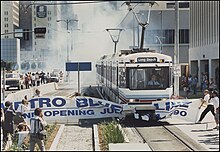
In the early 20th century, Southern California had an extensive privately owned rail transit network with over 1,000 miles (1,600 km) of track, operated by Pacific Electric (Red Cars) and Los Angeles Railway (Yellow Cars).[23] However, from 1927 revenue shortfall caused Pacific Electric to begin replacing lightly used rail lines with buses. In 1958 the remnants of the privately owned rail and bus systems were consolidated into a government agency known as the Los Angeles Metropolitan Transit Authority or MTA. By 1963, the remaining rail lines were completely removed and replaced with bus service.[citation needed]
In the following decades, growing traffic congestion led to increased public support for rail transit's return. Beginning in the 1970s, a variety of factors, including environmental concerns, an increasing population, and the price of gasoline led to calls for mass transit other than buses.[citation needed] The Los Angeles County Metropolitan Transportation Authority (LACMTA, now branded as Metro) began construction of the initial lines throughout the 1980s using revenues from a voter-approved increase in sales tax.[citation needed] The Blue (A) Line opened on July 14, 1990, 27 years after the final streetcar line closed. The system has been progressively expanded since. The following table shows this expansion's timeline:
Just before the opening of the Metro Rail, Proposition U passed, which halved the allowable residential density throughout much of Los Angeles. This reduced the viability of the Metro Rail by limiting dense residential housing near transit stations. Before 2000, none of the land near the stations was converted to residential use.[24]
| Segment description | Date opened | Current line(s) on segment |
Endpoints | Number of new stations |
Length (miles) |
Construction cost |
|---|---|---|---|---|---|---|
| Blue Line Initial Segment | July 14, 1990 | Pico – Anaheim Street | 17 | 19.1 | $2.2 billion | |
| Blue Line Long Beach Loop | September 1, 1990 | Anaheim Street – Pacific Avenue | 4 | 2.2 | ||
| Blue Line To Financial District | February 15, 1991 | Pico – 7th Street/Metro Center | 1 | 0.7 | ||
| Red Line MOS-1 | January 30, 1993 | Union Station – Westlake/MacArthur Park | 3[a] | 4.4 | $3.1 billion | |
| Green Line | August 12, 1995 | Redondo Beach – Norwalk | 13[a] | 20.0 | $1.5 billion | |
| Red Line MOS-2 West | July 13, 1996 | Westlake/MacArthur Park – Wilshire/Western | 3 | 2.0 | $3.4 billion | |
| Red Line MOS-2 North | June 12, 1999 | Wilshire/Vermont – Hollywood/Vine | 5 | 4.7 | ||
| Red Line MOS-3 | June 24, 2000 | Hollywood/Vine – North Hollywood | 3 | 6.3 | $2.3 billion | |
| Gold Line Initial Segment | July 26, 2003 | Union Station – Sierra Madre Villa | 12[a] | 13.7 | $721 million | |
| Gold Line Eastside Extension | November 15, 2009 | Union Station – Atlantic | 8 | 6.0 | $887 million | |
| Expo Line Phase 1 | April 28, 2012 | Flower/Washington – La Cienega/Jefferson[b] | 8 | 7.6 | $1.3 billion | |
| Expo Line To Culver City | June 20, 2012 | La Cienega/Jefferson – Culver City | 1 | 1.0 | ||
| Farmdale Station | Farmdale | 1[c] | – | |||
| Gold Line Foothill Extension | March 5, 2016[25] | Sierra Madre Villa – APU/Citrus College | 6[25] | 11.5[25] | $714 million | |
| Expo Line Phase 2 | May 20, 2016[26] | Culver City – Santa Monica | 7[26] | 6.6[26] | $1.5 billion | |
| L Line Little Tokyo Closure | October 24, 2020[27] | – | Little Tokyo/Arts District | -1[d] | -0.3[e] | – |
| K Line Initial Segment | October 7, 2022[28] | Expo/Crenshaw – Westchester/Veterans | 6[a] | 5.9[3] | $2.1 billion | |
| Regional Connector | June 16, 2023[29] | 7th Street/Metro Center – Little Tokyo/Arts District | 3 | 1.9 | $1.8 billion | |
| Total | 101 | 113.3[f] | $21.5 billion | |||
- ^ a b c d Segment also included significant expansion of an existing station(s): this was not counted as a new station.
- ^ In terms of added trackage; Expo Line was through service to 7th Street/Metro Center.
- ^ Infill station on the Expo Line between Expo/La Brea and Expo/Crenshaw; opened on the same day in conjunction with the Expo Line To Culver City.
- ^ The at-grade Little Tokyo/Arts District station was demolished to make way for the Regional Connector; it was replaced by an underground station nearby.
- ^ In terms of removed trackage; L Line service between Union Station and Pico/Aliso was discontinued.
- ^ Likely varies from the "official" Metro figure due to rounding differences.
Planned expansion
[edit]Metro has worked to plan and prioritize project funding and implementation. Metro's 2009 Long Range Transportation Plan (LRTP) was developed to provide a long-term vision of transportation system development for the next 30 years.[30] Metro worked to update the 2009 LRTP citing new housing trends and fiscal changes. Metro released the updated LRTP in 2020.[31]
Beginning in 2014, Metro saw its ridership numbers begin to decline. Many explanations exist for the decline, including safety concerns, an increase in ride-hailing service usage, low-income housing opportunities drying up in L.A. because of the increase in rents, and a shortage of housing.[32] Ridership declines also coincide with passage of AB 60, signed into law by Governor Brown in 2013, which provides for issuance of a vehicle operators license regardless of immigration status.[33][34]
The fiscal changes are the passage of Measure R, a countywide incremental sales tax increase passed by voters in 2008, providing funding for many of the highest priority projects in the LRTP.[35][non-primary source needed] On November 6, 2012, Metro attempted to pass Measure J,[36] but failed as it did not reach the two-thirds majority needed to pass.[37][38] In November 2016 election, Metro decided to place another sales tax on the ballot. The voters then approved Measure M, a half-cent permanent sales tax increase to fund many local projects, including Metro Rail expansion.[39]
In 2018, Metro approved renaming its rail lines using a letter-based scheme, similar to those in New York City.[40][41] Metro recommended the opening of the refurbished A Line in 2019 as a starting point to rename the lines,[42] and then continuing with the opening of the K line, finishing in time for the opening of the Regional Connector in 2023.[43][44]
Current and priority projects
[edit]The following rail projects have been given high priority by Metro. They all appear in the 2009 LRTP constrained plan,[30] and all have funding earmarked from Measure R.[35][45] With the passage of Measure M in 2016, Metro released an updated Long Range Transportation plan in February 2017, and released a full report in 2020,[46] along with its Twenty-eight by '28 initiative.[47]
| Concept name | Description | Construction | Operational | Status | Ref. |
|---|---|---|---|---|---|
| LAX Automated People Mover and |
Will connect LAX terminals and a new rental car facility to the Metro Rail system through the construction of an automated people mover system. Two K Line stations, LAX/Metro Transit Center and Aviation/Century, will open as this project is completed. | 2018–2024 | 2024 (C & K lines) 2026 (APM) |
Under construction | [48] |
| Section 1 extends the D Line west along Wilshire Blvd to La Cienega, Section 2 extends a further three miles west from La Cienega through Beverly Hills to Century City. Section 3 extends west to Westwood/UCLA and the VA Medical Center. All phases are under construction with plans to finish in time for the 2028 Summer Olympics. | 2015–2027 | 2025 (Section 1) / 2026 (Section 2) / 2027 (Section 3) | Under construction | [54][55][56][57][58][59][60] | |
| Further extends the northeast segment of the current A Line eastward from APU/Citrus College to Pomona. | 2019–2025 | 2025 | Under construction | [61][62][63][64][65][66] | |
| East San Fernando Valley Light Rail Transit Project | Constructs a light rail line connecting the east San Fernando Valley to the G Line, largely along the median of Van Nuys Blvd and San Fernando Road. The line will connect with Metrolink and Amtrak at the Van Nuys station and the future Sepulveda Transit Corridor. | 2024 | 2031 | Under construction | [67][68][69][70][71][72] |
| Southeast Gateway Line | Creates a new light rail line connecting Downtown Los Angeles to Artesia and the Gateway Cities, much of it along the West Santa Ana Branch. | 2025 | 2035[73] | Under construction | [74][75][76][77][78][79][80][81] |
| Further extends the southeast segment of the current E Line eastward along Washington Boulevard to Whittier. | 2025 | 2035 | Final EIR certified / NEPA clearance underway | [82][83][84][85] | |
| Extends the C Line from its current terminus in Redondo Beach towards Torrance and South Bay cities. By the time this extension is complete, the K Line will have taken over this extension after the C Line is rerouted to LAX/Metro Transit Center. | 2026 | 2033[86] | LPA adopted / Draft EIR in progress | [87][85] | |
| Sepulveda Transit Corridor Project Phases 1 and 2 | Planning is underway on a rail connection between the G Line and the East San Fernando Valley Transit Corridor (see above) in the Valley to the D and E lines on the Westside. Modes under consideration include a standalone rapid transit line; or a monorail, which unlike the other modes could traverse the Sepulveda Pass without tunneling. Existing local funding sources will provide approximately $5.7 billion for the project for a scheduled opening in the early 2030s; additional funds, including from public–private partnerships, are being sought to complete the line before the 2028 Summer Olympics. | 2028 | 2033–2035 (Phase 1) / 2057–2059 (Phase 2)[88] | Five LPA's analysis in progress / Draft EIR in progress | [89][90] |
| Create a new underground light rail line connecting the B Line's Hollywood/Highland station south to the D Line, and the K Line's Expo/Crenshaw station via Santa Monica Boulevard in West Hollywood. Possible north–south routes include Fairfax, La Brea, and San Vicente Boulevard. An extension north of the K Line is included as a Tier 1 Strategic Unfunded Plan project in the 2009 Long Range Transportation Plan. | 2041 | 2047 | Three LPA's analysis in progress / Draft EIR Completed | [30][91][92][93][94][95] | |
| Extend the B and D rapid transit lines from their eastern terminus at Union Station, south along the L.A. River to the Arts District, and possibly across the river along Whittier Bl to the Eastside. However, Metro is studying the possibility of adding one or two stops along the river in the Arts District as part of a project to improve and expand the rail yard already in the area to accommodate increased headways once the D Line extension west is completed. | Unknown | Unknown | Draft EIR in progress | [96][97][98][99] | |
| Vermont Transit Corridor | Create a new north–south route down Vermont Avenue between Wilshire/Vermont station, the Metro E Line and C Line. Included as a Tier 2 Strategic Unfunded Plan project in 2009 Long Range Transportation Plan; a bus rapid transit line has been funded in the near term by Measure M, but studies will be conducted for possible heavy rail rapid transit, as the Vermont corridor is Metro's second busiest public transportation corridor. | BRT 2020; HRT 2060 | BRT 2028–2030; HRT 2067 | Three LPA's analysis funded / Pending Draft EIR for BRT | |
| Converting the current G Line bus rapid transit route into light rail. Made possible after the 2014 repeal of state legislation prohibiting light rail along the G Line right of way, which had been enacted due to neighborhood opposition in the 1990s. Long term plans include complete conversion in phases with full replacement by 2057. Metro commenced BRT upgrades in 2018 to add grade crossing gates, and two new elevated segments at Van Nuys Bl and Sepulveda Bl, reducing travel time by 20%. | 2051 | 2057 | No current funds available for LRT until 2051 | [100][101][102] | |
| Extends the C Line from LAX northwest to Venice and Santa Monica Beach and possibly connect with the E Line's western terminus. The C Line was originally engineered to maintain compatibility with this extension. Included in City of Los Angeles Westside Mobility Plan, and as a Tier 2 Strategic Unfunded Plan project in 2009 Long Range Transportation Plan. | BRT 2043; LRT Unknown | BRT 2047; LRT Unknown | No LPA or EIR conducted | [30][103] |
Other expansion concepts
[edit]Metro's Long Range Transportation Plan was published in 2009,[30] and was updated in 2020.[31] The following proposed line/system expansions do not have funding or high priority in Metro's long-range plans. Some are listed as "strategic unfunded" in the last Long Range Transportation Plan, indicating some possibility they could be constructed should additional funding materialize. Others have been the subject of Metro Board discussion, with the possibility of future feasibility studies. (More information on each project can be found in the references.)
| Concept name | Description | Source |
|---|---|---|
| Burbank–Glendale Line | Would connect Downtown Los Angeles to Glendale and Burbank. Studied in the 1990s, and included as a Tier 1 Strategic Unfunded Plan project in 2009 Long Range Transportation Plan.[30] | [104][30] |
| B Line To Burbank Airport | Extend the Metro B Line 3.2 miles (5.1 km) from its northwestern terminus to Hollywood Burbank Airport. Included as a Tier 1 Strategic Unfunded Plan project in 2009 Long Range Transportation Plan.[30] | [30] |
| C Line To Norwalk Metrolink | Extend the C Line east to Norwalk/Santa Fe Springs station (Metrolink). Included as a Tier 1 Strategic Unfunded Plan project in 2009 Long Range Transportation Plan,[30] but is included among the Major Transit Projects (Figure 8) in the 2020 Long Range Transportation Plan with an estimated "open year" of 2052.[31] | [105] |
| "Pink Line"/"Silver Line" (former names) | DTLA Union Station thru Hollywood to Beverly Hills terminating at the under construction D Line Century City Station. Stops in or near Silver Lake, Dodger Stadium, Echo Park, West Hollywood and Century City. Mostly a Sunset Boulevard and Santa Monica Boulevard east–west route. Possibly using the already built HRT B Line tracks thru Hollywood or the LRT K Line under consideration in West Hollywood. East of Union Station would head to the City of La Puente or El Monte, CA. With possible stops in East L.A., Cal State LA, San Gabriel and Baldwin Park. No LPAs listed. No funds available. Listed as one of several "Strategic Unfunded Plan" project in the 2009 Long Range Transportation Plan, Tier 2.[30] Eastside route no longer met by the removed Eastside Transit Corridor option along The 60 Freeway. | [106][107][108][30] |
| Harbor Line | Light rail line to connect harbor area (San Pedro) to Metro A Line or C Line. Floated in LA City Council motions and Metro Harbor Subdivision studies. Also, a further southward extension of the C Line is included as a Tier 1 Strategic Unfunded Plan project in the 2009 Long Range Transportation Plan. Other plans could lead to the J Line being converted to rail.[30] | [109] |
| D Line Extension Phase 4 | Extend the Metro D Line 3.5 miles (5.6 km) from its under construction western terminus, Westwood/VA Hospital station to Downtown Santa Monica station. No funds available. | [110][111] |
| Venice Boulevard Corridor | Restore the Venice Boulevard right-of-way train service from Venice Beach in the west to Culver Junction area possibly heading north on La Brea Avenue to Hollywood or east into Downtown Los Angeles. Would service the westside and Central Los Angeles. Pacific Electric Venice Short Line was last used in the 1950s. | [112] |
See also
[edit]- Los Angeles County Metropolitan Transportation Authority
- Los Angeles Metro Rail rolling stock
- Breda A650
- Transportation in Los Angeles
- Measure R
- List of metro systems
- List of tram and light rail transit systems
- List of United States rapid transit systems by ridership
- List of United States light rail systems by ridership
References
[edit]- ^ a b c "Transit Ridership Report Second Quarter 2024" (PDF). American Public Transportation Association. September 3, 2024. Retrieved September 5, 2024.
- ^ a b "Transit Ridership Report Fourth Quarter 2023" (PDF). American Public Transportation Association. March 4, 2024. Retrieved September 5, 2024.
- ^ a b c d e "Facts At A Glance". Los Angeles County Metropolitan Transportation Authority. June 2023. Archived from the original on March 19, 2023. Retrieved June 22, 2023.
- ^ "Art – Los Angeles County Metropolitan Transportation Authority". May 20, 2024. Retrieved May 25, 2024.
- ^ "Metro Parking Lots by Line". metro.net. Retrieved May 25, 2024.
- ^ Hymon, Steve (August 10, 2012). "Designing a subway to withstand an earthquake". The Source. Archived from the original on December 15, 2018. Retrieved February 25, 2019.
- ^ "A beginner's guide to Metro". Time Out Los Angeles. March 25, 2024. Retrieved May 25, 2024.
- ^ "Metro Customer Code of Conduct" (PDF). Los Angeles County Metropolitan Transportation Authority. June 1, 2018. p. 11. Retrieved April 25, 2024.
- ^ a b "Metro Maps and Schedules". Los Angeles County Metropolitan Transportation Authority. December 10, 2023. Retrieved May 24, 2024.
- ^ Mitteenn, Mey Lyn (December 21, 2023). "Go Metro for free on Christmas Eve and New Year's Eve". The Source. Retrieved May 24, 2024.
- ^ "Coronavirus: Metro to end late-night rail service on Saturday". ABC7 Los Angeles. March 21, 2020. Retrieved May 25, 2024.
- ^ "Metro December 2023 Service Change" (PDF). Los Angeles County Metropolitan Transportation Authority. November 7, 2023. Retrieved July 10, 2024.
- ^ "FY 25 Proposed Budget" (PDF). Los Angeles County Metropolitan Transportation Authority. May 24, 2024. Retrieved May 24, 2024.
- ^ a b c "Fares - LA Metro". metro.net. Retrieved May 25, 2024.
- ^ "L.A. Metro Fare Capping Starts July 1 - Streetsblog California". cal.streetsblog.org. June 7, 2023. Retrieved July 1, 2023.
- ^ "Fare Capping". metro.net. Retrieved July 1, 2023.
- ^ "MTA's $46M system of locking turnstiles sits unused, waiting for fare cards to be adopted – LA Daily News". Dailynews.com. August 21, 2010. Archived from the original on August 25, 2010. Retrieved September 30, 2010.
- ^ "LA Metro Ridership Statistics".
- ^ "LAPD Officers to Patrol Metro Buses, Trains in the City of Los Angeles". lamayor.org. February 23, 2017. Archived from the original on June 2, 2020. Retrieved July 2, 2017.
- ^ "Riders with Other Forms of Transport Switching to Metro". www.metro.net. September 13, 2006. Archived from the original on March 9, 2014. Retrieved May 15, 2013.
- ^ "Meet Our Metro Ambassadors". metro.net. Retrieved May 25, 2024.
- ^ Uranga, Rachel; Jany, Libor (June 27, 2024). "Metro OKs plan to start its own police agency, wind down contracts with sheriff, LAPD". Los Angeles Times. Retrieved July 6, 2024.
- ^ Taplin, Michael (1991). "City of the Automobile: Los Angeles looks to Light Rail London". Light Rail Review 2. Platform 5 Publishing/Light Rail Transit Association. pp. 27–30. ISBN 1-872524-23-0.
- ^ Severen, Christopher (2023). "Commuting, Labor, and Housing Market Effects of Mass Transportation: Welfare and Identification" (PDF). Review of Economics and Statistics. 105 (5): 1073–1091. doi:10.1162/rest_a_01100. ISSN 0034-6535. S2CID 158142894.
- ^ a b c Nelson, Laura (March 5, 2016). "San Gabriel commuters cheer as Gold Line rail extension officially opens". Los Angeles Times. Archived from the original on March 5, 2016. Retrieved March 6, 2016.
- ^ a b c Hymon, Steve (February 25, 2016). "17 things to know about Expo 2 opening on May 20". The Source. Metro. Archived from the original on February 22, 2017. Retrieved May 21, 2016.
- ^ Jager, Rick. "Building the Last Phase of the Regional Connector Transit Project Requires A 22-Month Closure of Little Tokyo/Arts District Station Effective Saturday, Oct. 24 through Fall 2022". Metro. Retrieved October 4, 2023.
- ^ Patel, Tine (October 7, 2022). "LA Metro's new K Line opens today". CBS. Archived from the original on October 7, 2022. Retrieved October 7, 2022.
- ^ Von Quednow, Cindy (June 16, 2023). "Metro Regional Connector opens in Los Angeles, bringing more direct access to downtown". KTLA. Nexstar Media Group. Retrieved June 16, 2023.
- ^ a b c d e f g h i j k l m "2009 Long Range Transportation Plan" (PDF). Los Angeles County Metropolitan Transportation Authority (Metro). 2010. p. 31. Archived (PDF) from the original on February 26, 2015. Retrieved January 9, 2016.
- ^ a b c 2020 Long Range Transportation Plan (PDF) (Report). Metro. 2020. Archived (PDF) from the original on January 23, 2021. Retrieved March 13, 2021.
- ^ Chiland, Elijah (May 22, 2019). "Is Metro ridership down because low-income passengers are leaving LA?". Curbed LA. Archived from the original on May 22, 2019. Retrieved May 23, 2019.
- ^ "AB 60 Driver Licenses". California Department of Motor Vehicles. Archived from the original on December 4, 2020. Retrieved December 13, 2020.
- ^ "L.A. Metro Ridership". Propel L.A. Archived from the original on November 27, 2020. Retrieved December 13, 2020.
- ^ a b "Measure R". Metro. Archived from the original on September 19, 2010. Retrieved September 30, 2010.
- ^ "Measure J". Metro. Archived from the original on October 12, 2012. Retrieved October 21, 2012.
- ^ "Measure J Fails". County of Los Angeles Registrar-Recorder. Archived from the original on January 14, 2013. Retrieved January 12, 2013.
- ^ "Transit Backers Seek to Change State Law". Los Angeles Times. December 4, 2012. Archived from the original on December 17, 2012. Retrieved January 12, 2013.
- ^ Nelson, Laura J. (June 23, 2016). "Metro puts half-cent sales tax increase for transportation projects on November ballot". Los Angeles Times. Archived from the original on October 4, 2016. Retrieved October 4, 2016.
- ^ Hymon, Steve (April 7, 2015). "PowerPoint: Metro staffs proposal to rename rail and BRT lines". The Source. Metro. Archived from the original on April 11, 2015. Retrieved April 9, 2015.
- ^ "LA Metro Could Switch Rail Line Names From Colors To Letters". Curbed Los Angeles. Curbed Staff. April 3, 2015. Archived from the original on September 22, 2015. Retrieved April 9, 2015.
- ^ "More intersection, road closures for Blue Line upgrades". Long Beach Post. Archived from the original on February 28, 2019. Retrieved March 24, 2019.
- ^ "Plan 2018-0684 – Metro Board". Boardagendas.metro.net. November 15, 2018. Archived from the original on November 13, 2019. Retrieved February 15, 2020.
- ^ "Transit Maps: New Official Map: Los Angeles Metro with Regional Connector, 2023". Transit Maps. June 12, 2023. Retrieved May 25, 2024.
- ^ "Transit Program – Project Management – Project Budget and Schedule Status" (PDF). Metro. June 19, 2014. Archived (PDF) from the original on November 14, 2016. Retrieved August 16, 2014.
- ^ "Long Range Transportation Plan". Metro.net. Archived from the original on February 14, 2020. Retrieved February 15, 2020.
- ^ "Twenty-Eight by '28 Initiative". Metro.net. Archived from the original on February 19, 2021. Retrieved March 19, 2021.
- ^ Metro, L. A. (June 21, 2022). "Metro Board of Directors has June meeting this Thursday at 10 a.m." The Source. Archived from the original on July 7, 2022. Retrieved July 7, 2022.
- ^ "Airport Metro Connector". Metro. Archived from the original on April 10, 2021. Retrieved November 19, 2014.
- ^ "City Council approves long-awaited people mover to LAX". Los Angeles Times. April 11, 2018. Archived from the original on April 12, 2018. Retrieved April 12, 2018.
- ^ GmbH, finanzen net. "Fluor Announces Financial Close on Los Angeles International Airport Automated People Mover". markets.businessinsider.com. Archived from the original on July 18, 2020. Retrieved March 13, 2021.
- ^ "The K Line opens Friday, October 7!". The Source. September 22, 2022. Archived from the original on March 23, 2023. Retrieved September 22, 2022.
- ^ "2024-0212 - STAFFING REQUEST FOR LAX/METRO TRANSIT CENTER OPENING AND RELATED C AND K LINE RECONFIGURATION". Los Angeles County Metropolitan Transportation Authority. Retrieved August 29, 2024.
- ^ "Purple (D Line) Extension Transit Project". Metro. Archived from the original on September 29, 2019. Retrieved November 20, 2021.
- ^ "Summer 2013 – General Fact Sheet – Purple Line Extension" (PDF). Metro. Archived (PDF) from the original on October 3, 2018. Retrieved July 25, 2013.
- ^ Notice to proceed issued for section 2 of the Purple Line Extension Archived November 25, 2020, at the Wayback Machine, the source.metro.net, 2017/04/27.
- ^ Sotero, Dave (November 10, 2014). "Long wait over: groundbreaking held for Wilshire Boulevard subway extension". The Source. Metro. Archived from the original on January 24, 2021. Retrieved November 19, 2014.
- ^ "D Line Subway Extension Project – Section 1". Metro. Retrieved July 9, 2024.
- ^ "D Line Subway Extension Project – Section 2". Metro. Retrieved July 9, 2024.
- ^ "D Line Subway Extension Project – Section 3". Metro. Retrieved July 9, 2024.
- ^ Newton, Damien (October 5, 2019). "Foothill Gold Line to Pomona Is Officially Under Construction – Streetsblog Los Angeles". La.streetsblog.org. Archived from the original on January 23, 2021. Retrieved February 15, 2020.
- ^ Pacheco, Antonio (June 28, 2017). "L.A. pushes ahead with $1.4 billion Gold Line extension". Archpaper.com. Archived from the original on August 8, 2020. Retrieved February 15, 2020.
- ^ Márquez, Liset (April 26, 2018). "There's now enough money to build the Gold Line through to Montclair – Daily Bulletin". Dailybulletin.com. Archived from the original on April 11, 2021. Retrieved February 15, 2020.
- ^ "Metro approves $1.4B construction plan for Gold Line extension to Claremont – Curbed LA". La.curbed.com. June 23, 2017. Archived from the original on August 13, 2017. Retrieved February 15, 2020.
- ^ "Background". Foothill Gold Line. Retrieved April 14, 2024.
- ^ "Foothill Extension".
- ^ "East San Fernando Valley Transit Corridor". Metro. July 8, 2014. Archived from the original on August 19, 2014. Retrieved August 16, 2014.
- ^ "The Valley will get light rail: Metro board approves north–south line along Van Nuys Boulevard". Los Angeles Times. June 28, 2018. Archived from the original on May 21, 2020. Retrieved April 16, 2020.
- ^ Sotero, Dave (December 3, 2020). "Metro Board approves Final EIR for East San Fernando Valley Light Rail Transit Project". The Source. Metro. Archived from the original on December 5, 2020. Retrieved December 17, 2020.
- ^ @numble (June 28, 2022). "Updates on LA Metro's East SFV rail project schedule were provided recently at an employee meeting. Current schedule is start receiving construction (PDB) contract bids in Summer 2022, award contract in 2023, and complete project in 2028" (Tweet). Retrieved October 7, 2022 – via Twitter.
- ^ @numble (November 27, 2023). "October 2023 status report for LA Metro's East San Fernando Valley line. Contractor's initial schedule shows line opening at end of 2031, Metro is targeting summer 2031" (Tweet). Retrieved November 28, 2023 – via Twitter.
- ^ Scauzillo, Steve (July 28, 2024). "Metro gets rolling on San Fernando Valley light rail construction". Los Angeles Daily News. MediaNews Group. Retrieved August 2, 2024.
- ^ "Metro Board approves route for initial segment for West Santa Ana Branch Project and Union Station as northern terminus". The Source. January 28, 2022. Archived from the original on February 3, 2022. Retrieved February 3, 2022.
- ^ "West Santa Ana Transit Corridor". Metro. Archived from the original on June 13, 2018. Retrieved June 12, 2018.
- ^ "Home". pacificelectriccorridor.com. Archived from the original on July 17, 2010. Retrieved September 30, 2010.
- ^ "West Santa Ana Branch Transit Corridor" (PDF). Los Angeles County Metropolitan Authority. April 2017. Archived (PDF) from the original on August 22, 2017. Retrieved October 10, 2022.
- ^ "West Santa Ana Branch Transit Corridor". Los Angeles County Metropolitan Authority. Archived from the original on January 29, 2022. Retrieved January 29, 2022.
- ^ "EIS_EIR". Dropbox. Retrieved April 17, 2024.
- ^ "Metro certifies environmental impact report for Southeast Gateway Rail Line". Los Angeles Daily News. MediaNews Group. April 25, 2024. Retrieved April 25, 2024.
- ^ @numble (April 25, 2024). "LA Metro has released the RFP for a contractor for "Advanced Works" for Southeast Gateway Line, to prepare alignment for main project construction (utility relocations, soil abatement, freight relocation, etc.). Contract might also include building C Line infill transfer station" (Tweet). Retrieved April 29, 2024 – via Twitter.
- ^ "Metro Awarded $231 Million for Southeast Gateway Line". Los Cerritos Community News. October 23, 2024. Retrieved October 31, 2024.
- ^ "Eastside Transit Corridor Phase 2". Metro. May 6, 2014. Archived from the original on August 5, 2014. Retrieved August 16, 2014.
- ^ Metro, L. A. (July 1, 2022). "Draft Environmental Impact Report (EIR) released for extension of L Line to Whittier". The Source. Archived from the original on August 19, 2022. Retrieved July 7, 2022.
- ^ "Final EIR (April 2024)". Dropbox. Los Angeles County Metropolitan Transportation Authority. Retrieved April 26, 2024.
- ^ a b Sharp, Steven (May 24, 2024). "Metro moves forward with Eastside and South Bay rail extensions Neither project is expected to open for passengers". Urbanize LA. Urbanize Media LLC. Retrieved May 25, 2024.
- ^ "Green Line Extension to Torrance Fact Sheet" (PDF). Metro. March 2019. Archived (PDF) from the original on April 10, 2019. Retrieved April 10, 2019.
- ^ "C Line (Green) Extension to Torrance". LA Metro. Retrieved June 29, 2023.
- ^ "We're exploring alternatives to the 405". LA Metro ArcGIS StoryMaps. May 20, 2024.
- ^ "Rail concepts released for Sepulveda Transit Corridor project – The Source". Thesource.metro.net. June 7, 2018. Archived from the original on June 2, 2020. Retrieved February 15, 2020.
- ^ "Sepulveda Transit Corridor Project". LA Metro. Retrieved June 29, 2023.
- ^ "WHAM – West Hollywood Advocates for Metro Rail". Whamrail.com. Archived from the original on February 5, 2020. Retrieved February 15, 2020.
- ^ Sharp, Steven (July 23, 2018). "Five Options Under Consideration for the Crenshaw/LAX Line's Northern Extension". Urbanize LA. Archived from the original on June 15, 2020. Retrieved February 15, 2020.
- ^ "Actions taken by Metro Board today – The Source". Thesource.metro.net. May 24, 2018. Archived from the original on July 11, 2020. Retrieved February 15, 2020.
- ^ Hymon, Steve (August 17, 2020). "Three routes recommended for further study on K Line Northern Extension project". The Source. Metro. Archived from the original on September 3, 2020. Retrieved August 18, 2020.
- ^ "KNE_DraftEIR". Dropbox. Los Angeles County Metropolitan Transportation Authority. Retrieved August 14, 2024.
- ^ Vaillancourt, Ryan (May 27, 2010). "Los Angeles Downtown News and Information". Los Angeles Downtown News – the Voice of Downtown Los Angeles. Ladowntownnews.com. Archived from the original on March 23, 2023. Retrieved September 30, 2010.
- ^ Nelson, Laura J. (March 18, 2015). "Metro could expand subway service to the downtown L.A. Arts District". Los Angeles Times. Archived from the original on May 29, 2015. Retrieved May 28, 2015.
- ^ "Metro Board considers item for formal study of Arts District Station – The Source". Thesource.metro.net. June 20, 2018. Archived from the original on July 31, 2020. Retrieved February 15, 2020.
- ^ Hymon, Steve (March 30, 2021). "Scoping meetings in April for upcoming Arts District Station environmental report". The Source. LACMTA. Archived from the original on March 30, 2021. Retrieved March 30, 2021.
- ^ Hymon, Steve (July 9, 2014). "Transportation headlines, Wednesday, July 9". The Source. Metro. Archived from the original on January 11, 2016. Retrieved January 19, 2016.
- ^ Olga, Grigoryants (July 17, 2018). "LA's Metro says improvements are in the works for the Orange Line, with light rail in mind". Los Angeles Daily News. Archived from the original on July 17, 2018. Retrieved July 17, 2018.
- ^ "Metro breaks ground on Orange Line Improvements Project – The Source". Thesource.metro.net. October 12, 2018. Archived from the original on June 14, 2020. Retrieved February 15, 2020.
- ^ "Measure M project descriptions – The Source". The Source. Thesource.metro.net. November 8, 2016. Archived from the original on September 8, 2020. Retrieved February 15, 2020.
- ^ BURBANK-GLENDALE-LOS ANGELES RAIL TRANSIT PROJECT (PDF) (Report). Metro. 1992. Archived (PDF) from the original on December 10, 2019. Retrieved August 24, 2020.
- ^ Weikel, Dan (January 10, 2016). "Closing 2.8-mile transit gap in Norwalk could smooth regional commute". Los Angeles Times. Archived from the original on August 12, 2019. Retrieved January 19, 2016.
- ^ "Metro Silver Line – Los Angeles Light Rail Trains from El Monte to Silver Lake // Silverline, Mass Transit". metrosilverline.com. Archived from the original on October 29, 2005.
- ^ "The National Transit Coalition". thetransitcoalition.us. Archived from the original on February 16, 2009. Retrieved May 21, 2007.
- ^ Freemark, Yonah (October 18, 2010). "Realizing the Impossible: Los Angeles' Subway Extension « The Transport Politic". The Transport Politic. Thetransportpolitic.com. Archived from the original on April 18, 2020. Retrieved February 15, 2020.
- ^ "harborline". harborline.blogspot.com. Archived from the original on June 27, 2020. Retrieved May 13, 2006.
- ^ "Does L.A. Need the Santa Monica Purple Line Extension?". Urbanize LA. January 31, 2017. Archived from the original on March 12, 2021. Retrieved March 13, 2021.
- ^ "L.A.'s not-quite 'subway to the sea' finally breaks ground". Los Angeles Times. November 8, 2014. Archived from the original on February 18, 2020. Retrieved February 18, 2020.
- ^ "Who Are We Building Transit For?". LA Streetsblog. January 9, 2020. Archived from the original on August 2, 2020. Retrieved July 31, 2020.
External links
[edit]- History of the Metro Rail System
- Network map (to-scale)
- Google map of Metro Rail/Busway stations
- Go Metro – Rail Map
- Image of the underground construction of Metro Rail system in Los Angeles, California, 1989. Los Angeles Times Photographic Archive (Collection 1429). UCLA Library Special Collections, Charles E. Young Research Library, University of California, Los Angeles.
- Los Angeles Metro Rail
- 1990 establishments in California
- Passenger rail transportation in California
- Public transportation in Los Angeles County, California
- Railway lines opened in 1990
- Standard gauge railways in the United States
- Transportation in Los Angeles
- Underground rapid transit in the United States
- 750 V DC railway electrification


